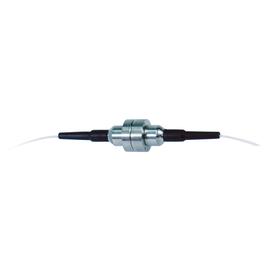Cable reels in harbour cranes – rotary joints are a crucial component for transmission of power and signals
In cranes at ports, cable reels are commonly used to transmit power and control signals to the crane machinery from a fixed power source or remote-control system.
- Power: Cable reels transmit electrical power, sometimes up to several thousand kW to the crane machinery with its motors and lights.
- Control signals: Cable reels can additionally transmit control signals that allow the crane operator to control the movement of the crane machinery, such as raising or lowering the load, moving the crane trolley, or swinging the crane boom.
- Video and data signals: Some cranes use video cameras and other sensors to provide information about the load and the environment around the crane. Cable reels can transmit these video and data signals to the control system, allowing the crane operator to monitor the load and make informed decisions.
- Communication signals: Cable reels can also transmit communication signals, such as radio or telephone signals, that allow the local crane operator to communicate with other workers on the ground or on other parts of the crane.
Harbour cranes are the essential interface between vessels and the freight transport on land. Cable reels in such cranes play a critical role in the safe and efficient operation of mobile and fixed cranes at harbours by transmitting power, control signals, and other important data and information. This becomes even more critical with the increasing automation and digitization of loading infrastructure in harbors.
The rotary joint allows for continuous transfer of electrical power and signals
Rotary joints are a crucial component for transmission of power and signals in cable reels used in cranes at ports. The primary function of a rotary joint in a cable reel is to enable the transfer of electrical power, control signals, and other types of data and information from the fixed power source and control system to the rotating cable reel drum and the crane machinery.
The rotary joint is typically installed at the center of the cable reel, and it consists of a stationary part (stator) and a rotating part (rotor). As the cable reel drum rotates, the rotary joint allows for continuous transfer of electrical power and signals from the fixed power source and control system to the crane machinery without any interruption. This continuous transfer of power and signals ensures that the crane can operate efficiently and safely.
There are several key requirements that must be considered when designing and selecting rotary joints for cable reels used in cranes at harbors. These requirements include:
- High performance: SPINNER rotary joints offer low insertion loss or excellent VSWR (Voltage Standing Wave Ratio) performance, ensuring reliable transfer of electrical power, radiofrequency or optical signals with minimal power loss or signal distortion.
- Durability and reliability: SPINNER rotary joints are designed and manufactured to withstand harsh environmental conditions, which includes exposure to dust, moisture, saltwater corrosion in marine environments or high temperatures, and frequent use, ensuring reliable and long-lasting performance. They are designed to withstand the constant rotation of the cable reel drum and the stresses associated with crane operation.
- Minimal maintenance requirements: SPINNER rotary joints require minimal maintenance and are designed for easy repair and replacement, reducing downtime and maintenance costs.
- Wide range of options: SPINNER offers a wide range of rotary joint options, including different sizes, frequencies, technologies and (rf, fiber optics, Ethernet, …) and power handling capabilities, allowing for greater customization and flexibility in design.
- Integration with automation systems: SPINNER rotary joints can be integrated with automation systems for remote monitoring and control, allowing for more efficient and streamlined operations.
SPINNER rotary joints offer several advantages, including a wider range of options, higher electrical performance, and better durability and reliability. Additionally, SPINNER's focus on customization and flexibility allows for more tailored solutions to meet the specific needs of different port and crane applications.












